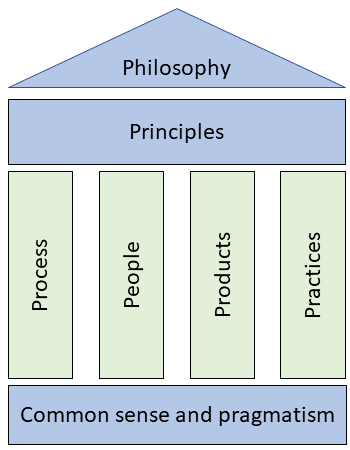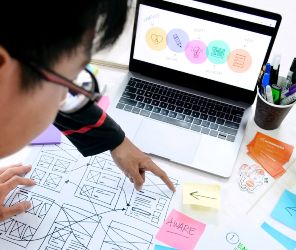
Origin of DSDM
The Dynamic Systems Development Method (DSDM) is often regarded as a well-kept secret in the Agile domain.
Launched in 1995, DSDM has the longest-standing history among Agile methods and is the only method that emphasizes managing Agile projects.
In the years following 2000, DSDM emerged as a preferred Agile approach for software developers seeking alternatives to rapid application development (RAD) techniques. One of the main limitations of RAD was its inability to scale effectively for team collaboration. By facilitating teamwork and scaling, DSDM became one of the pioneering Agile methodologies used by the software development community.
DSDM contributed to the establishment of the Agile Alliance and the Agile Manifesto in 2001. The philosophy and principles of DSDM had an influence on the Manifesto for Agile Software Development, even though DSDM applies the Agile concept to more than just software.
In a nutshell, DSDM was practicing Agile before the term gained widespread recognition!
Introduction of DSDM Atern
In 2007, a significant update to the DSDM methodology brought about the creation of DSDM Atern. The name ‘Atern’ was inspired by the Arctic Tern, a bird acclaimed for its exceptional collaboration skills and the capacity to cover vast distances. This symbolism was an appropriate choice for the rebranding of the DSDM method.
In 2014, due to misunderstandings regarding the term ‘Atern,’ another modification to the method was deemed necessary. The decision was made to return to the original DSDM name, which was universally acknowledged. Consequently, DSDM and DSDM Atern are now considered synonymous!
Incorporating the Agile Project Framework in DSDM
In 2014, DSDM’s rebranding brought forth the Agile Project Framework. The DSDM Agile Project Framework has established itself as the leading, proven agile approach that meets the dual requirements of present-day organizations: governance and rigor, as well as agility and flexibility.
The Agile Project Framework within DSDM aids organizations in resolving common project difficulties, such as late delivery, budget overruns, or final deliverables that are unfit for their purpose.
Agile Project Management through DSDM
DSDM was a pioneer in introducing agile project management capabilities to agile frameworks. Unlike Scrum, which is focused only on product delivery during an iteration, DSDM addresses project management aspects as well, differentiating it from most other agile frameworks.
DSDM’s ability to cater to a wide range of agile requirements made it the chosen foundation for the rapidly evolving AgilePM (Agile Project Management) qualifications, which are accredited by APMG International and the Agile Business Consortium.
DSDM – An Agile Process
DSDM is a repetitive agile framework initially devised to effectively deliver software projects. Similar to other agile frameworks and methodologies, DSDM was created in response to the challenging waterfall processes that had become prevalent in the software development industry during the late 20th century.
DSDM’s Advancement
DSDM is now advancing as agile methodologies become more refined. This advancement is due to organizations needing increased rigor and control when applying agile in situations where the ‘ideal agile environment’ is not available.
DSDM is an agile method that addresses the needs of both simple product development projects with co-located teams, and more complex projects involving multiple distributed teams working in different countries and time zones. DSDM can scale up to handle multiple teams working in dispersed environments, something that scaled agile frameworks have only recently started providing.
DSDM Fundamentals
Not Restricted to IT
DSDM’s background, like most agile frameworks and methods, is rooted in the software development industry. However, over the last decade, agile has expanded and is no longer confined to IT.
DSDM can easily be applied to projects outside of software development. In fact, it can be implemented in any type of product development project. By delivering a usable product incrementally at the end of each timebox, DSDM can provide business value early in the product development lifecycle.
DSDM: Autonomous or Integrated
The DSDM Agile Project Framework can be used either as an autonomous method or integrated with other well-known project management methods such as PRINCE2, MSP, and PMI.
It is also an excellent wrapper for more limited Agile approaches like Scrum, ensuring that the entire project lifecycle is covered. DSDM also enables Scrum to be scaled up for use beyond just product development.
DSDM Constituents

DSDM is an agile project framework that comprises several aspects:
- philosophy
- practices
- people
- principles
- process
- products
- pragmatism and common sense.
All these aspects contribute to a philosophy of delivering business benefits as early as possible, ensuring the best possible return on investment (ROI) for an organization.
DSDM’s ‘logic and pragmatism’ may seem strange to some, but this flexibility helps DSDM avoid the inflexibility that can sometimes plague other Agile approaches.
A basic assumption of DSDM is that nothing is built perfectly the first time around. Typically, 80% of a solution’s value can be delivered for 20% of the effort required to produce the full solution.
By concentrating on the business need, DSDM supports projects that align strategically with an organization’s change portfolio.
DSDM Core Principles
DSDM is founded on 8 core principles that represent its spirit, culture, and approach to work. These principles must be actively monitored at all times, as any compromise on a principle can jeopardize the successful execution and completion of a project.
DSDM aligns closely with agile principles, focusing on delivery, effective communication, collaboration, and continuous delivery. All DSDM principles contribute to harmonizing DSDM practices with the agile philosophy.
Familiarizing yourself with DSDM’s guiding principles is crucial if you’re considering enrolling in an agile project management course, such as AgilePM®, which is based on the DSDM method.
We will now look at the 8 DSDM principles.
1. Focus on the business need
- Understand business priorities.
- Create a valid business case.
- Enable continuous business commitment.
All decisions made throughout your project should coincide with the overall project objectives. Projects should function as a means to reach long-term business goals. Using methods like MoSCoW and timeboxing help to maintain focus on delivering what businesses require, exactly when they require it.
2. Deliver on time
- Use timeboxing.
- Focus on priorities.
- Predict deliveries.
Adhering to delivery schedules is often essential. For steady deliveries, organize all timeboxes ahead of time. Features could vary, but the delivery dates have to remain fixed.
3. Cooperate and collaborate
- Promote stakeholder collaboration.
- Focus on team building.
- Work with business representatives.
Teams need to be capable of working together and making informed decisions for those they represent. Enlist subject matter experts in your team to guarantee the sharing of information. Stakeholders can offer their know-how and experiences to project teams by attending periodic workshops.
4. Never compromise quality
- Set quality level at the start.
- Ensure quality doesn’t vary.
- Document and test.
Decide on the desired quality level at the beginning of the project. All efforts must be focused on reaching this agreed level. Carry out early testing on deliverables and perform constant evaluations.
5. Build incrementally
- Deliver business benefit early.
- Reassess priorities with each iteration.
- Confirm that the work is correct.
DSDM maintains that prior to beginning development, teams need to be well-versed in the scope of the business challenge. Don’t get bogged down in overly detailed analysis of requirements, as this could stall development.
6. Develop iteratively
- Use customer feedback.
- Create Enough Design Up Front (EDUP).
- Evolve and be creative.
DSDM is deeply rooted in the concept of iterative delivery. Accept that it’s unusual for perfection to be attained from the get-go and be prepared to make adjustments within your project to achieve victory.
7. Communicate continuously
- Manage expectations.
- Keep documentation simple.
- Interact through workshops.
Inspire team collaboration by scheduling stand-ups and workshops. Demonstrate your work regularly and early with models and prototypes. Continually advocate for informal, in-person dialogue within the team.
8. Demonstrate control
- Be proactive.
- Timebox work and review regularly.
- Evaluate project viability.
Optimize project oversight by openly sharing plans and progress with everyone. Execute formal documentation processes. Determine progress by paying attention to the products delivered, rather than tasks finished.
Processes
DSDM is an iterative and incremental framework. The most essential business needs are delivered promptly, while those of lesser priority are handled later.
Being iterative, DSDM allows business representatives to evaluate an unfolding solution, contribute feedback, and propose alterations during the course of its development.
Phases
The DSDM process model consists of 6 distinct phases. A pre-project phase and post-project phase set it apart from most Agile approaches that are solely focused on delivery.
The DSDM phases include:
- Pre-project.
- Feasibility.
- Foundations.
- Evolutionary development.
- Deployment.
- Post-project.
People
In DSDM, people from both the business and development backgrounds are involved throughout the iterative and incremental journey.
Each individual in a project is given explicit roles and responsibilities and collaborates in timeboxes to keep the project running smoothly.
DSDM stands out from other Agile techniques by specifying the duties of the project manager role.
Practices
DSDM highlights 4 crucial practices.
Timeboxing
Similar to other agile frameworks, DSDM schedules work in fixed time periods (timeboxes), akin to sprints in Scrum. The objective is to produce a working product at the conclusion of each iteration (timebox). Therefore, DSDM incorporates both an incremental and iterative technique for product development.
Facilitated workshops
Facilitated workshops unite project stakeholders to collaborate on defining business requirements and promoting mutual understanding.
Modelling and iterative development
Modelling enables team members to visualize a business domain and improve their grasp of it. Modelling is employed to develop diagrammatic representations of specific aspects of the system or business area being developed.
DSDM leverages a short feedback loop with the customer to deliver a functional software increment at the end of each iteration. The MoSCoW prioritization technique is suggested for choosing the requirements for the team to tackle during a timebox. Requirements are generally expressed as user stories.
DSDM also incorporates prototyping, focusing on rapid development, quick feedback, and early issue identification. The core DSDM philosophy underscores the significance of detecting and addressing problems as early as possible.
MoSCoW prioritization
The MoSCoW prioritization method aids businesses in organizing requirements by identifying Must have, Should have, Could have, and Won’t have requirements for each timebox.
Distinguishing DSDM from Scrum
Many people within the Agile community mistakenly view Scrum as a project management technique. In reality, Scrum is a development method that promotes team collaboration on both project-related and non-project-related tasks to iteratively generate products that offer value to customers.
Scrum does not discuss the actions that occur before a project (pre-project) or after a solution has been deployed (post-project). The pre-project stage requires an assessment of the project’s value, while the post-project stage involves examining the solution’s benefits and considering any needed improvements.
Conversely, DSDM delves into the pre-project and post-project phases and outlines the project manager’s duties. DSDM functions as an agile project management framework, while Scrum serves as a product delivery framework. It is important to note that Scrum can be implemented in DSDM projects during the other four project phases.
DSDM infographic
The following infographic shows the DSDM principles in greater detail.

Summary
The DSDM Agile Project Framework provides a time-tested and reliable method for agile project delivery, having been effectively implemented in a vast number of projects around the globe.
At present, DSDM is the sole agile project management framework. The framework continues to demonstrate its proficiency in working seamlessly within and supplementing existing corporate processes.
DSDM’s application in IT and non-IT projects dates back to 1994, and its significant productivity gains have been independently endorsed by the UK Software Metrics Association.
For more information on how DSDM can help improve your Agile project delivery, or for details about agile project management training, please contact us at agileKRC.
agileKRC has helped shape agile thinking by leading the teams that developed AgilePM® and PRINCE2 Agile®. We take a practical, success-oriented approach. We begin by taking the time to listen and understand your needs, before offering our real-world experience and expert guidance.













